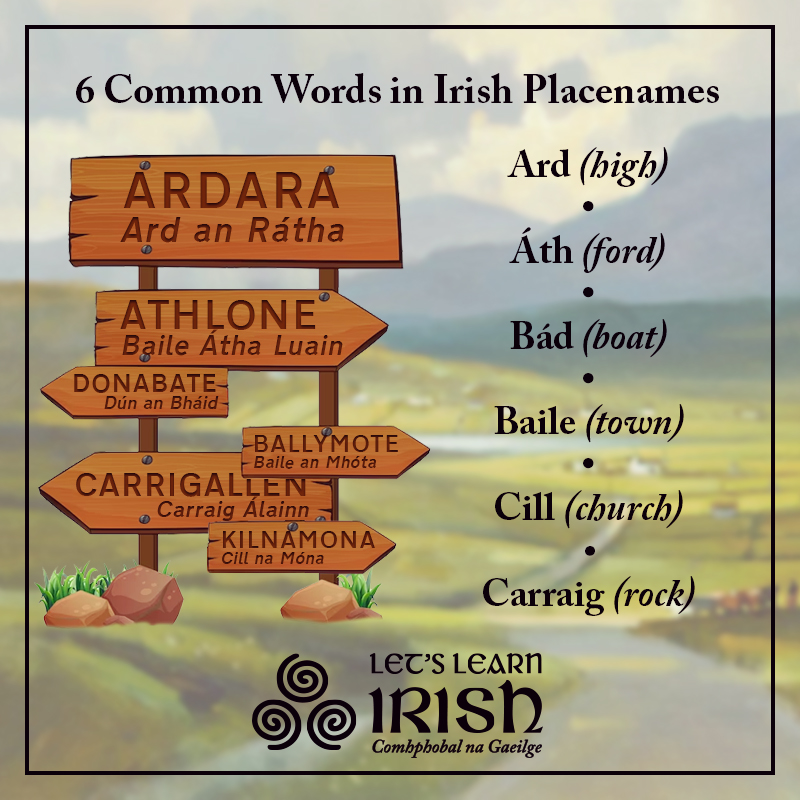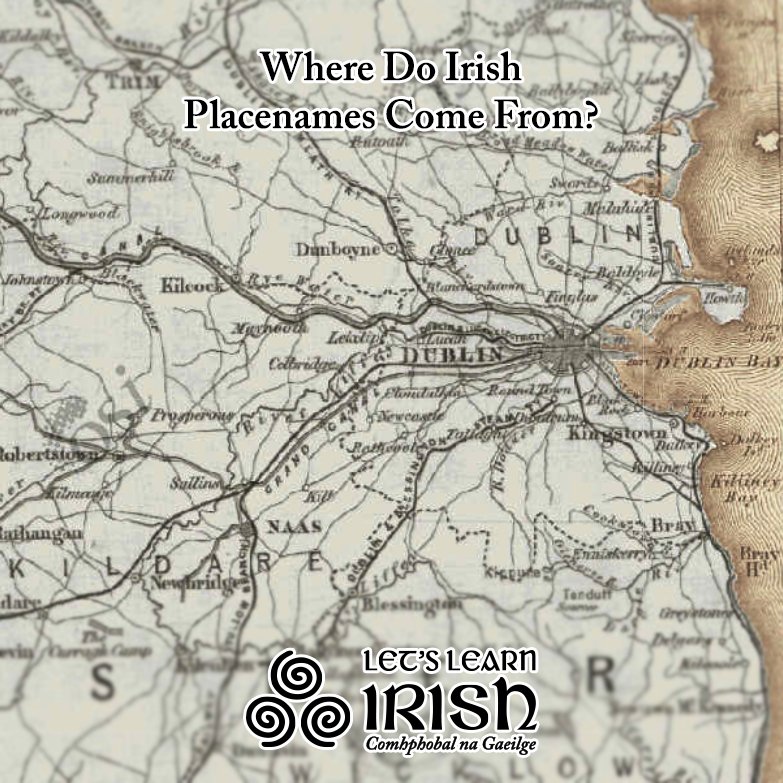Irish Placenames: Tír, Gleann, Lios, Ráth, Loch
Logainmneacha / Placenames
Where do we get the names of places such as Tyrone, Glenamaddy, Lisdoonvarna, Rathfarnham or Loughanure?
What’s wonderful about studying Irish placenames is discovering that we know so much more Irish than we first suspect! We can tell that Glenbeg refers to a ‘small valley’, once we notice that it’s made up of the words ‘gleann’ (valley) and ‘beag’ (small), words we have encountered many times before.
The history of placenames, and how we ended up with the versions that we now use, is intriguing. In our first article on ‘logainmneacha’, we profiled places featuring Ard, Áth, Bád, Baile, Cill and Carraig. In our second article, we focused on examples using Cluain, Cnoc, Coill, Droim and Dún. Now, in this article, we look at examples of places using the terms Tír (land), Gleann (valley), Lios (ringfort), Ráth (ringfort) and Loch (lake).
Tír
The term ‘tír’ broadly means ‘country’, ‘land, ‘territory’ or ‘people of’, and can be found in reference to all land sizes, from provinces to villages and from counties to parishes. Notable examples include:
Tír Eoghain (‘Eoghan’s territory’) refers to Co. Tyrone. This Gaelic kingdom originally included parts of present-day Co. Tyrone, Armagh, Derry and Donegal.
Tír Conaill, named after Eoghan’s brother Conall, was a kingdom of Gaelic Ireland that encompassed parts of Donegal, Sligo, Leitrim, Tyrone, Fermanagh and Derry.
Tír Dhá Ghlas (Terryglas), meaning ‘land of the two streams’, is a village in Co. Tipperary.
Tír na Móna (Tirnamona), referring to ‘territory of the bog’, is located in Co. Monaghan.
Tír Oileáin, anglicised as ‘Terryland’, is a townland in the city of Galway. The name most likely refers to ‘the district of the island’.
Tír an Iúir (Terenure), located in Co. Dublin, means ‘land of the yew tree’.
Gleann
‘Gleann’ is an extremely common term in Irish placenames, and usually denotes a ‘valley’ or ‘glen’. Below are placenames featuring ‘gleann’:
Gleann na Madadh (Glenamaddy/Glennamaddy) is a small town in Co. Galway, and well-known as a musical focal point during the 1960s showband era. The name may refer to ‘valley of the dogs’ due to the shape of the Glenamaddy Turlough as looked at from above, or perhaps ‘valley of the Black Plain’ (Gleann na Maighe Duibhí), presumably a reference to the turlough lake in the area which dries up every year, thus leaving behind a black plain of limestone. The song “Four Country Roads“, which mentions Glenamaddy, was a hit for Big Tom in Ireland in 1981. Interestingly, Big Tom hailed from Castleblayney, Co. Monaghan, home of the Glencarn Hotel, a venue he often played, which leads us to…
Gleann an Chairn (Glencairn), in Co. Waterford, is home to the only Cistercian monastery for women in Ireland. As also seen in the example of Ráth Cairn, a ‘cairn’ is a man-made pile of stones raised for a purpose, most typically used to mark a burial mound.
If you’re travelling north, it’s worthwhile visiting Páirc Náisiúnta Ghleann Bheatha (Glenveagh National Park), Ireland’s second-largest national park. This name means ‘glen of the birches’. Over 170 square kilometres, visitors can see the Derryveagh Mountains, Lough Veagh and Glenveagh Castle, as well as a multitude of exotic and delicate plants.
Variations of An Gleann Mór (‘the big glen’) lie in Co. Kerry and Kilkenny. In the opposite direction, An Gleann Beag (Glenbeg), meaning ‘the small glen’, can be found in Co. Monaghan, Kerry, Cork and Tipperary, to name but a few. Glenbeg Lough is a freshwater lake, located on the Beara Peninsula in Co. Cork.
When it comes to colours, An Gleann Dubh (Glenduff), referring to the ‘black valley’, lies in Co. Kerry, Tipperary and Cork, whereas Gleann Buí (Glenboy), the ‘yellow valley’, can be found in Co. Leitrim.
Gleann Dá Loch (Glendalough) is a glacial valley in Co. Wicklow. The name means ‘valley of two lakes’, and here you will find the well-known Early Medieval monastic settlement founded by St Kevin in the 6th century.
Lios
Lios translates as ‘ringfort’ or ‘enclosure’. Curiously, ‘lios’ does not hold the same prestige as the similar terms of ‘dún’ and ‘ráth’ (see below), and does not feature in any heroic sagas. ‘Lios’ can often be found qualified by a colour, such as Lios Bán (white) in Co. Mayo, Monaghan and Limerick, Lios Dubh (black) in Co. Cavan and Mayo, Lios Liath (grey) in Co. Armagh and Derry, Lios Buí (yellow) in Co. Antrim, Cork and Down), and Lios Ruadh (red) in Co. Clare, Cork, Kerry and Waterford. Further examples include:
Lios Dúin Bhearna (Lisdoonvarna), immortalised in Christy Moore’s song, is a spa town in Co. Clare in Ireland that’s famous for its music and festivals. The translation of the name is ‘fort of the gapped keep’.
Lios Mór (Lismore), meaning ‘great ringfort’, a historic town in Co. Waterford.The village of An Lios Breac (Newtown Forbes) in Co. Longford refers to ‘the speckled ringfort’. Interestingly, this village was previously called Lisbrack, an anglicisation of the Irish name.
Lios na Scéithe (Lisnaskea) in Co. Fermanagh, refers to the ‘fort of the shield’.
Another example is Lios Tuathail (Listowel), a heritage market town in Co. Kerry and home of a famous writer’s festival, horse racing and author John B. Keane. The name references ‘Tuathal’s ringfort’.
Ráth
Similar to ‘lios’, when you see the word ‘ráth’ in Irish place names, it is usually referring to a ringfort. It may also be used to describe an enclosed dwelling. Notable examples can be found throughout the country, particularly in Leinster, but it is remarkably scarce in Ulster. On the otherhand, ‘lios’ is more commonly found in the north, but less so in the south-east. In the vast majority of cases, both ‘ráth’ and ‘lios’ refer to ringforts. Ráth can also be found prefixing Anglo-Norman names, such as Rathwalter (Co. Tipperary), Rathgilbert (Co. Laois) and Rathjordan (Co. Limerick), which indicates that the term was still being used in place-naming during the Anglo-Norman period.
The villages of Ráth Chairn and Baile Ghib make up the Meath Gaeltacht. The Ráth Chairn Gaeltacht was founded in 1935 when 41 families from Conamara moved east, to live on land acquired by the Land Commission. Families were provided with newly built homes, a farm of approximately 8.9 hectares (22 acres), a sow, piglets and other basics. It was hoped that these families would benefit from a higher quality of life and greater crop yields, while also addressing the decline of the Irish language. In 1967, Ráth Chairn gained official recognition as a Gaeltacht.
Ráth Fearnáin (Rathfarnham) refers to ‘Fearnán’s ringfort’, and is a suburb on the south side of Co. Dublin.
Ráth Eanaigh (Raheny) is a suburb of Dublin City, located halfway from the city centre to Howth. It’s name potentially refers to the ringfort of Éanna, an early local chief, or from eanach, an old Irish word for marsh or swamp or passage through a swampy area.
Ráth an Dúin (Rathdown), a barony in Co. Wicklow, derives its name from Rathdown Castle, located near Greystones, and most likely refers to a ‘ringed fortress of the fort’.
An Ráth Mhór (Rathmore) means ‘big ringfort’. This is a small town in Co. Kerry, located close to the Cork border.
Ráth an Iúir (Rathnure), which translates as ‘ringfort of the yew trees’, is a small village close to Enniscorthy, in Co. Wexford.
Loch
The Irish term for lake is ‘loch’, which is also used to refer to an ‘inlet of the sea’. The term is commonly Anglicised as ‘lough’.
You will find, in north-west Co. Donegal, Loch an Iúir (Loughanure), meaning ‘lake of the yew’.
Baile Locha Riach (Loughrea), in Co. Galway, refers to the ‘town of the grey/ speckled lake’.
The quiet village of Loch Glinne (Loughglinn/Loughglynn) in Co. Roscommon, is named after the lake to the north of the village, and translates as ‘Glinna’s lough’.
Glasloch village, in north Monaghan, refers to a ‘green lake’, and is famous for hosting Paul McCartney’s wedding in 2002.
Lochán an Bhealaigh (Loughanavally/Loughnavally) is a village in Co. Westmeath, refers to the ‘little lake of the valley’.
Loch gCál (Loughgall), a small village in Co. Armagh that is surrounded by orchards, means ‘lake of the cabbages (kale)’.
Loch na bhFear (‘the lake of the men’) is home to Lough Navar Forest, a spectacular site of bog, heath, open water, native woodland and coniferous forest in west Co. Fermanagh, spanning 2,600 hectares (6425 acres).
Join the online Irish community for cúrsaí, comhrá & ceardlanna, and follow along on social media @LetsLearnIrish – beidh fáilte romhat!






